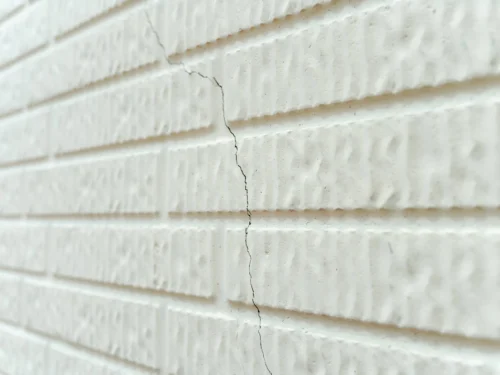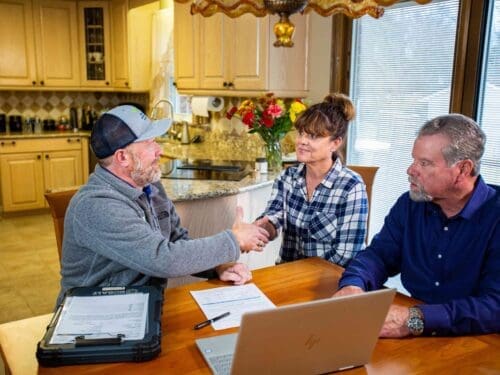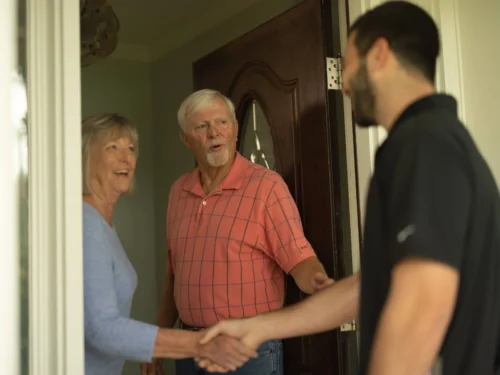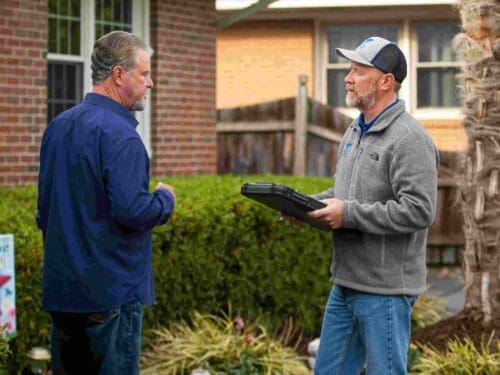That small line creeping along your basement wall isn’t just a cosmetic flaw — it’s a red alert for something bigger. And if you’re seeing it now, waiting even a few weeks could mean the difference between a simple fix and an expensive foundation crack repair.
Not all cracks mean structural danger but ignoring the wrong kind can cost you big. Hairline cracks from concrete shrinkage are often harmless. But wide, horizontal, or expanding cracks? Those are signs of movement and movement means trouble.
What starts as a thin fracture can quickly open the door to:
- Water intrusion and mold growth
- Sagging floors and stuck doors
- Structural damage that kills resale value
- Rising repair costs with every season
With spring rains and summer soil shifts coming, you have a narrow window to act before things spiral for what could’ve been fixed fast and affordably.
Think it’s not urgent? Think again. Read the blog to find out why acting now could save your home.
The Science Behind Foundation Cracks — And Why They Get Worse Over Time
1. Your Foundation Moves More Than You Think
Your foundation isn’t sitting on solid rock. It’s resting on layers of soil — and that soil is constantly changing with the weather:
- Spring: Melting snow and rain saturate the soil. If your drainage is poor, water builds up around the foundation.
- Summer: Heat and drought dry out the soil, causing it to shrink and pull away from the foundation.
- Fall/Winter: Soil re-expands or freezes, pushing against the foundation with new force.
This constant expansion and contraction creates stress points. And once a crack starts, the structural integrity is already compromised. If you’re in an area with shrink-swell soils, you’re at even greater risk.
FACT: Over 25% of U.S. homes are built on expansive soil. These soils account for more property damage annually than floods, hurricanes, and earthquakes combined (American Society of Civil Engineers).
2. The Freeze-Thaw Cycle Is a Silent Destroyer
In cold months, moisture enters small cracks. Then it freezes, expands and pushes the concrete outward. This widens the crack.
As spring hits, the ice melts and carries more water into the opening. Then summer rains soak the soil again. And if this cycle continues unchecked, even minor cracks turn into serious structural liabilities.
Here’s what can happen next:
- Cracks widen across basement walls and floors
- Water seeps in, leading to mold or wood rot
- The foundation shifts, pulling your house structure with it
Every season of inaction raises the stakes and the home foundation crack repair cost. Want to stay ahead of freeze-thaw damage this year? Use this cold weather home prep checklist.
Why You Should Never Ignore Foundation Cracks
Some homeowners wait to fix cracks, thinking they’ll “watch and see” if it gets worse. Here’s the truth: it always gets worse — just slowly enough to feel manageable until it’s not.
Loss of Structural Integrity
- Bowed basement walls
- Uneven floors or sagging beams
- Cracks in drywall or brick exteriors
- Doors and windows that don’t shut properly
These are signs your home’s structure is shifting — and that puts your entire house at risk.
Skyrocketing Repair Costs
A minor vertical crack might be relatively low cost to seal if addressed promptly. But if left untreated, water pressure can widen the crack—leading to more extensive repairs like carbon fiber straps or, in severe cases, full wall bracing or excavation. The longer you wait, the deeper the damage becomes making the cost of repairs much higher.
Pro Tip: Repairs get exponentially more expensive the longer you wait. Every season adds more labor, materials, and potential demolition to the job.
Water Damage, Mold, and Indoor Air Hazards
Moisture from foundation cracks:
- Leads to mold and mildew
- Damages insulation and drywall
- Promotes pest infestation
- Hurts indoor air quality and causes allergies
Water entering your home isn’t just an annoyance — it’s a long-term health and financial liability.
Lower Resale Value
If an inspector sees foundation issues, buyers run. Even if you don’t plan to sell soon, a foundation crack flagged by a realtor or appraiser can kill your home’s value or delay closing.
How to Spot Foundation Damage Before It Escalates
You don’t need to be a contractor to spot early warning signs. Here’s what to look for:
| Sign | What It Means |
| Cracks in foundation walls | Expansion pressure or soil shift |
| Diagonal cracks near windows or doors | Structural movement |
| Gaps between wall and floor or ceiling | Foundation settling |
| Sloping or bouncy floors | Uneven foundation support |
| Musty smell or visible mold | Water entering through cracks |
| Water pooling in basement/crawl space | Drainage issues or crack infiltration |
Some cracks are cosmetic. Others mean your foundation is moving — fast.
Here’s how to know:
- Hairline vertical crack: Monitor it.
- Crack wider than 1/8″ or growing: Call a pro.
- Horizontal crack or bowing wall: Get immediate inspection.
When in doubt, get it checked, early diagnosis is always cheaper than a delayed repair.
How Professionals Repair Cracks in Foundation — And Why DIY Doesn’t Cut It
DIY crack sealers can help with small, dry, hairline cracks — especially if they’re not growing.
But for anything leaking, wider than 1/8″, or tied to shifting walls or floors? DIY is just a short-term band-aid. You’ll still need a pro to address the root cause.
Professional Foundation Crack Repair Methods
Carbon Fiber Reinforcement
Best for:
- Bowing or bulging walls caused by lateral soil pressure
- Long horizontal or stair-step cracks that indicate wall displacement
- Preventing future movement once structural cracks are stabilized
Not ideal for:
- Walls that have already shifted more than 2 inches — may require steel bracing instead
- Active leaks — carbon fiber reinforces strength, but doesn’t seal moisture
Remember: Carbon fiber straps are thin, strong, and can be installed without excavation. They stabilize walls but don’t repair the crack itself.
Outside Foundation Crack Repair
Best for:
- Persistent water intrusion from outside
- Cracks caused by hydrostatic pressure or poor drainage
- Homes where long-term waterproofing is the goal
Not ideal for:
- Minor cosmetic cracks — this is a major home foundation crack repair and overkill for small fixes
- Areas where excavation isn’t feasible (tight property lines, hardscaping)
Remember: This is the gold-standard fix for water issues — but also the most invasive and expensive.
Floor Crack Repair
Best for:
- Cracks in basement floors or garage slabs from soil settlement
- Uneven floors due to voids beneath the concrete
- Sealing entry points for moisture or radon gas
Not ideal for:
- Cosmetic surface cracking — can often be monitored or sealed with minor products
- Structural foundation issues affecting load-bearing walls
Remember: Often paired with slab lifting or soil stabilization if the crack is caused by sinking.
Crawl Space Repair
Best for:
- Cracks or damage from moisture, poor support, or wood rot under the home
- Homes with crawl spaces that get damp or moldy
- Preventing future settling with jack supports and vapor barriers
Not ideal for:
- Foundation wall cracks — this is more about stabilizing the underside of your home, not sealing concrete walls
Remember: Encapsulation improves air quality, keeps moisture out, and helps stop crawl space-related foundation shifting.
Why Spring & Summer Are the Ideal Seasons for Repairs
Timing your repairs right makes a big difference:
- Easier Soil Access – Dry and warm weather makes it easier to dig, patch, seal, and stabilize.
- Faster Project Timelines – Winter’s over — no frozen ground, no snow delays, no holiday rush.
- Prevent Spring Water Damage – Address cracks now before spring rain pushes more water into your home.
- Beat the Rush – Spring and summer are peak repair seasons. Act now to avoid scheduling delays and higher prices.
What to Do Right Now — The Smart Homeowner’s Action Plan
You’ve seen a crack. Now what? Here’s exactly what to do — and why it matters.
Step 1: Conduct a 360° Visual Inspection — Inside and Out
Don’t just look at the crack itself. Inspect the entire perimeter of your home, both outside and inside. Here’s where and what to look for:
Exterior:
- Walk the full foundation perimeter.
- Look for vertical, horizontal, or stair-step cracks.
- Check for signs of water pooling or poor drainage.
Interior (Basement/Crawl Space):
- Examine corners, walls, and slab floors.
- Use a flashlight to spot spiderweb cracks or moisture.
- Check for uneven flooring, gaps between walls and ceilings, or exposed rebar.
Why this matters: Many cracks form out of sight. If you only focus on one crack, you may miss deeper or spreading issues. Foundation damage is rarely isolated.
Step 2: Measure and Document What You See
Take high-quality photos and write down:
- Location of each crack (e.g., “South basement wall, 3 feet from corner”)
- Size and direction (horizontal, vertical, stair-step; use a ruler)
- Any moisture presence (dry, damp, active leak)
- Date of observation — you’ll want to track changes
Pro Tip: Recheck in 2–3 weeks. If cracks have widened, that’s a strong indicator of active movement or worsening conditions.
Why this matters: Documentation helps professionals assess the crack’s progression and severity. It also protects you when selling your home — you’ll show that you took action early.
Step 3: Don’t Patch It Yourself — And Don’t Wait for It to “Settle”
We get it, you’re handy and YouTube makes foundation crack repair look easy. But surface sealants only mask the symptoms. They won’t fix:
- Hydrostatic pressure behind the wall
- Shifting or sinking soil
- Structural strain in support beams or slabs
Waiting also doesn’t help. Cracks don’t “settle” or stabilize on their own — they’re evidence of movement. Delaying just means more movement, more water, and more money later.
Why this matters: DIY repairs are temporary and often fail. Plus, you may void your home warranty or delay the discovery of a larger issue.
Step 4: Schedule a Professional Foundation Inspection — Immediately
Time to bring in a trained eye. A foundation repair expert will:
- Evaluate the entire structure, not just one crack
- Identify whether it’s a structural or non-structural issue
- Use tools like levels, moisture meters, and laser scans to assess movement
- Recommend targeted solutions, not upsells
Why this matters: Early professional inspection means you stay in control — of the problem, the timeline, and the cost. It’s proactive, not reactive.
Not sure what to expect during the inspection? Here’s exactly how long a foundation inspection takes and what it includes.
When to Call a Professional for Foundation Cracks
Not every crack needs urgent attention — but certain signs should trigger an immediate call to a qualified foundation repair company. If you notice any of the following, it’s time to stop guessing and bring in a pro:
- Horizontal cracking across foundation walls — often a red flag for dangerous pressure buildup
- Bulging or bowing walls, especially in basements, which signal structural shifting
- Vertical foundation cracks wider than 1/8″ or expanding over time
- Water intrusion after heavy rains or flooding, indicating deeper drainage or wall failure issues
- Foundation lifting or settling, leading to uneven floors or large gaps under baseboards
- Cracks near windows, doors, or corners that cause frames to misalign or stick
- Foundation collapse risk, especially if chunks of concrete are crumbling or separating
- Recurring cracks after DIY patching, which usually points to an underlying issue never addressed
- Need for advanced solutions like carbon fiber and steel bracing.
- Considering foundation replacement or major renovation, which always requires professional evaluation
When in doubt, protect your home’s structural integrity and call a licensed contractor who can provide a real diagnosis — and the right foundation crack repair solution for your situation.
Bonus: Know What to Ask Your Inspector
You’re not just looking for a “yes or no” answer. Instead of asking how to fix crack in my foundation, ask your foundation specialist:
- What caused this crack?
- Is it likely to worsen — and how fast?
- What repair method do you recommend and why?
- Will this fix be permanent or require monitoring?
- How will this affect my home’s resale value or insurance?
Why this matters: Informed homeowners make better financial decisions. Asking the right questions avoids overspending or ignoring urgent repairs.
Final Thought: Take Action While You Still Have Control
Every season you delay means more soil movement, more water, and more stress on your home. A foundation problem doesn’t show up overnight — but by the time the signs are visible, it’s already progressed. But, it is highly treatable when caught early. Quick action can stop moisture, restore structural strength, and protect your investment.
You saw the crack. You read the signs. Isn’t it time to find out what it really means?
Virginia Foundation Solutions offers free inspections and expert guidance. Call us at 757-340-0917 or schedule your free foundation crack repair inspection today.
You’ve invested in your home — now protect it before a simple crack becomes a serious problem.








